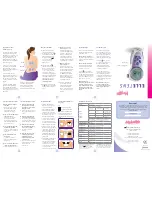
TB7300 SERIES COMMUNICATING FAN COIL THERMOSTATS
62-2018—05
16
BI2
Binary input no.2 configuration
Default value =
None
None):
No function will be associated with the input
(Door Dry) Door contact and Motion detector
: This configuration
is only functional if binary input #1 is set to
Motion N.O.
or
Motion
N.C.
or a
PIR accessory cover
is used.
With this sequence enabled, the occupancy is now dictated through
those 2 inputs. Any motion detected will set the zone to occupied
status. The zone will remain permanently in occupied mode until the
door contact switch opens momentarily. The thermostat will then go
in stand-by mode. If more movements are detected, the occupied
mode will resume. While the door is opened, any movements
detected by the remote PIR sensor or the PIR accessory cover will
be ignored. Use a Normally Closed contact switching device.
•
Contact opened = Door opened
•
Contact closed = Door closed
(RemOVR):
temporary occupancy remote override contact. This
function disables the central button override function on the
thermostat. The override function is now controlled by a manual
remote momentarily closed contact. When configured in this mode,
the input operates in a toggle mode.
It is now possible to toggle between unoccupied and occupied
setpoints for the amount of time set by parameter (
TOccTime
)
temporary occupancy time.
(Filter):
a backlit flashing Filter alarm will be displayed on the
thermostat LCD screen when the input is energized. It can be tied to
a differential pressure switch that monitor filters
•
Contact opened = No alarm
•
Contact closed = Alarm displayed
(Service)
: a backlit flashing
Service
alarm will be displayed on the
thermostat LCD screen when the input is energized. It can be tied in
to the AC unit control card, which provides an alarm in case of
malfunction.
•
Contact opened = No alarm
•
Contact closed = Alarm displayed
UI3
Universal input no.3
configuration
Default value =
None
(None):
No function will be associated with the input
(COC/NH) Change over dry contact. Normally Heat
: Used when
both heating and cooling are controlled from the same thermostat
output. Contact closes when cold air/water is present. Only used and
valid if system parameter (
Out1Conf
) is set at 2.0
(COC/NC) Change over dry contact. Normally Cool:
Used when
both heating and cooling are controlled from the same thermostat
output. Contact closes when hot air/water is present. Only used and
valid if system parameter (
Out1Conf
) is set at 2.0
(COS) Change over analog sensor
: Used where heating and
cooling are controlled from the same output. Temperature in duct/
pipe determines control mode (heat/cool). Only used and valid if
system parameter (
Out1Conf
) is set at 2.0
(SS) Supply air sensor monitoring
: Used for supply air
temperature monitoring.
Only used for network reporting of the supply air temperature.
Has no internal function in the thermostat
MenuScro
Menu scroll
Default value =
On
= Scroll
active
Removes the scrolling display and only presents the room
temperature to the user. With this option enabled, no status is given
of mode, schedule and outdoor temperature. Outdoor temperature
only displays if a network variable is received.
On = Scroll active
Off = Scroll not active
AutoMode
Enables
Auto
menu for Mode
button
Default value =
On
Enables Auto function for the mode button
For sequences 2, 4 and 5 only
On = Auto active
(Off-Cool-Heat-Auto)
Off = auto not active
(Off-Cool-Heat)
C or F
Sets scale of the thermostat
Default value =
°F
°F
for Fahrenheit scale
°C
for Celsius scale
On hotel models, this sets the default value when the thermostat
powers up
Table 11. Configuration parameters
Configuration
parameters
Default value
Significance and adjustments









































